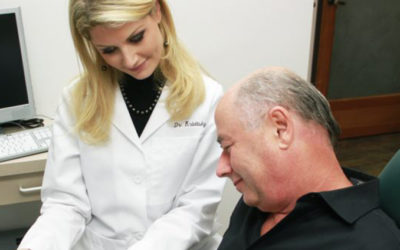So You Have Gum Disease – Now What?
Depending on the symptoms and severity of gum disease, treatment options can range from a gingival flap procedure to a bone or gum graft surgery to treat recession. Periodontal disease ranges in severity, from mild gum irritation and bleeding in early stage gingivitis to gum, bone, and potential tooth loss if left untreated.
The best defense against periodontal disease is prevention. Practicing good oral hygiene (daily brushing and flossing, supplemented with yearly oral exams and professional dental cleanings) and a healthy lifestyle is key to maintaining healthy teeth and gums for the long haul. Like all health conditions, some people can also be genetically predisposed to developing gum disease, making preventive and follow-up care even more important.
Signs and Symptoms of Early and Advanced Periodontal Disease
In many cases, gum inflammation (gingivitis) is an early warning sign of gum disease, although not every case of gingivitis results in periodontitis. Bleeding and tender gums are a sign that a visit to the dentist is necessary to clear away the plaque and tartar buildup that accumulates between the teeth and gums as a result of lingering bacteria. A thorough professional cleaning often clears up the build-up and takes care of the inflammation, bleeding, and irritation of the gums.
Schedule an appointment with a periodontal specialist if you are suffering from any of the following signs and symptoms of gum disease:
- Bright red, swollen, tender gums
- Receding gums
- Spacing between the teeth
- Pus/foul smelling and tasting discharge between the teeth and gums
- Bad breath
- Loose teeth
- Newly developed malocclusions/bite problems
The Effects of Periodontal Disease on Oral and General Health
Persistent inflammation of the gums can lead to the formation of pockets where bacteria can pool and proliferate. If left untreated, it can eventually lead to erosion of the gum and bone tissue, which can ultimately result in tooth loss. Gum inflammation has also been linked to complications with other health problems.
How to Treat Periodontal Disease
Beverly Hills-based specialists Dr. Alexandre Amir Aalam and Dr. Alina Krivitsky offer several gum disease treatment options for all levels of periodontal disease, from early diagnosis and prevention to treatment for advanced gum and bone recession and tooth loss.
Can Gum Disease Be Avoided?
The best defense is prevention with strong and consistent oral hygiene and regular visits to the dentist for professional cleanings one to two times per year, depending on the patient. While lifestyle factors like oral healthcare and diet play a large role in dental and periodontal health, there are other factors that can also increase the risk of periodontal disease for some people.
Schedule an appointment with a gum specialist at the Center for Advanced Periodontal and Implant Therapy in Beverly Hills if you are worried about your risk, or exhibit any of the common risk factors of periodontal disease including:
- Genetics and family history
- Weak immune system (common with patients undergoing treatment for cancer, HIV positive, and diabetes)
- Hormone fluctuations
- Malocclusions (bite problems)
- Ill-fitting dentures and restorations
- Lifestyle factors like bad nutrition, smoking, and excessive alcohol consumption
- Gingivitis
While periodontal disease can affect people of all ages, the risk increases as people grow older. With proper care and treatment, it is possible to maintain healthy teeth and gums well into old age. In addition, periodontal scaling and root planning, a preventive procedure, can clear plaque and bacteria buildup under the gums in order to prevent the onset of gum disease.
Gum and Osseous Surgery in Beverly Hills
While gum disease can be fought, it can often result in serious gum and bone loss before it is stopped. However, there are numerous periodontal disease procedures available at the Center for Advanced Periodontal and Implant Therapy that restore tissue lost from gum disease, including:
- RejuvaGum Lift – Uses regenerative medicine techniques (advanced platelet rich fibrin) to repair gum recession
- Dental Implants – A permanent replacement for missing teeth where the root of the tooth is restored with an implant, which then anchors the cosmetic crown and helps to retain the surrounding bone tissue in the jaw
- Bone Graft – Replaces lost bone tissue from trauma, periodontal disease, or tooth loss
- Sinus Lift (Augmentation) – Adjusts the height of the sinus floor to make room for dental implants and restorations
- Gum Graft/Lift – Soft tissue graft to treat gum recession
- Pocket Reduction Surgery – Cleans pockets of bacteria and plaque buildup under the gums
- Ridge Modification – Defects in the jawbone are filled with bone or bone substitute to build up the ridge in order to create a stable surface for a dental implant
Learn more about gum disease at WebMD.com.
GUM DISEASE CASE STUDY: BEFORE AND AFTER
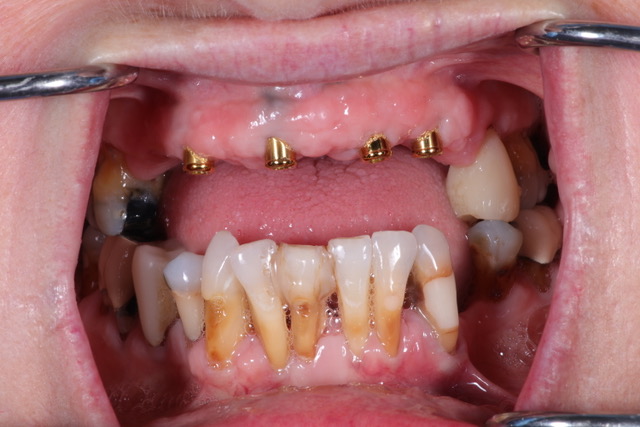
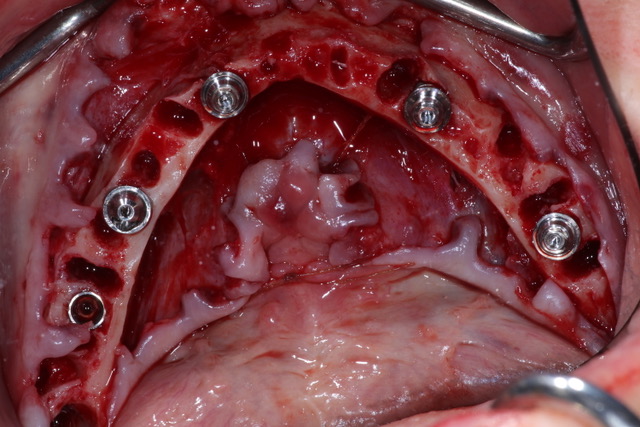
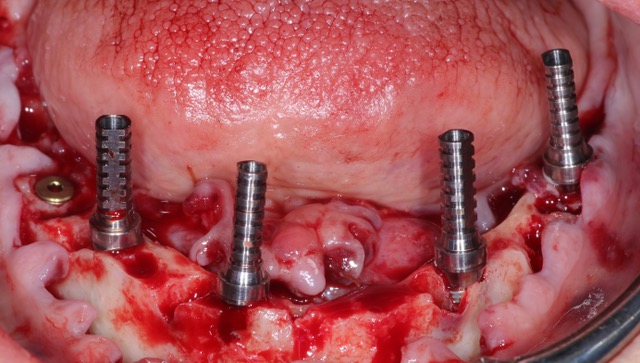
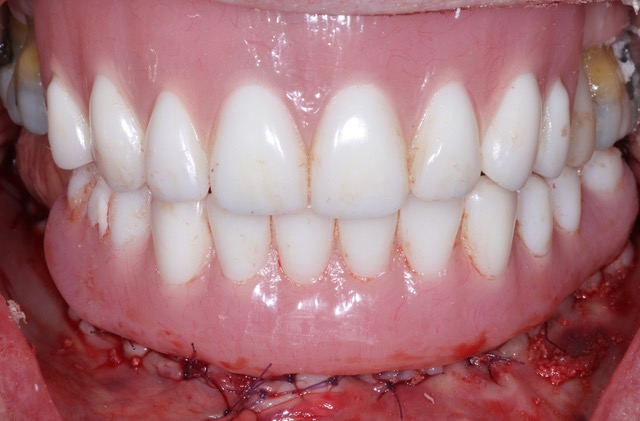
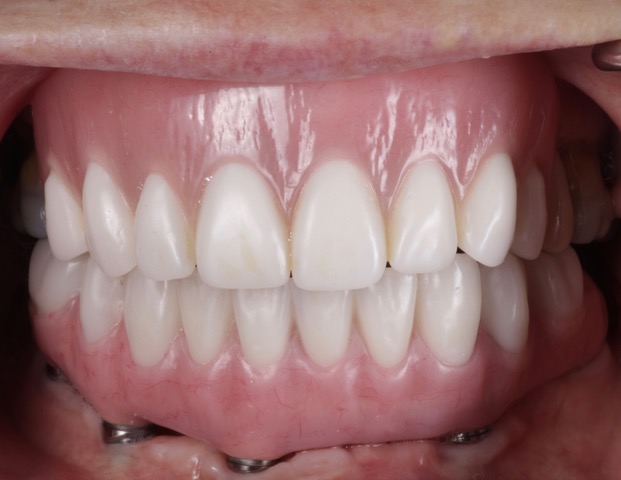
The Problem: When left untreated, periodontal disease can progress to extreme cases of periodontitis, that cause the teeth and gums to decay and completely fall out. This patient came in with an advanced case of periodontitis, where the gums were so inflamed, his top teeth completely fell out. As evident in the picture, he also experienced extreme decay in the bottom teeth as well. Not only was this patient in need of a complete smile transformation, but he also needed the restore his oral health. Periodontal disease can cause a number of health complications, and if left untreated not only affects one’s smile, but also overall health. Did you know periodontal disease can affect heart and respiratory health, brain health and cause pregnancy complications? It is imperative to treat periodontal disease at the onset when it begins with gingivitis, a mild inflammation, to avoid detrimental health effects down the line.
The Solution: After a thorough diagnosis, Dr. Aalam determined this patient would need to have his bottom teeth completely removed, and multiple dental implants would be placed in both in the upper and lower jaw to restore this patient’s smile.
The Treatment: In his first appointment, the infected lower teeth were removed, and five permanent dental implants were immediately placed in the upper jaw. In order for the patient to leave with what appeared to be a complete set of teeth, to avoid any embarrassment as well as discomfort when chewing and speaking, we worked with Dr. Stephanie Young, who provided a fixed temporary prosthesis on the day of the procedure.
After three months, the tissue around the implants completely healed, and the osseointegration process was complete. This is the process where the permanent dental implants naturally fuse to the jaw bone, as the new implants serve as the ‘tooth roots.’ A final full arch zirconia reconstruction was secured to the lower jaw to replace the teeth that were removed. In this case, we placed an overdenture, a particular type of dental prosthesis, on the upper jaw, to complete this patient’s smile, and restore his oral health!
Find the Best Gum Disease Treatment in Los Angeles
For more information on gum disease prevention, diagnosis, and treatment options, contact the Center for Advanced Periodontal and Implant Therapy by calling 310-826-8242 to schedule an appointment with Dr. Alexandre-Amir Aalam and Dr. Alina Krivitsky today.
You May Also Like...
Understanding the Microbiome of the Mouth: Why Balance Matters for Gum Health
We often think of brushing, flossing, and regular cleanings as the cornerstones of oral health. But beneath these...
The Real Cure for Periodontitis: Dispelling Myths About Gum Disease Treatment
Periodontitis, commonly known as gum disease, has long been regarded as a chronic condition that can only be managed,...
Senior Periodontal Care and the Challenges Aging Presents
As we journey through the stages of life, there's one aspect that demands consistent consideration — our oral health....



